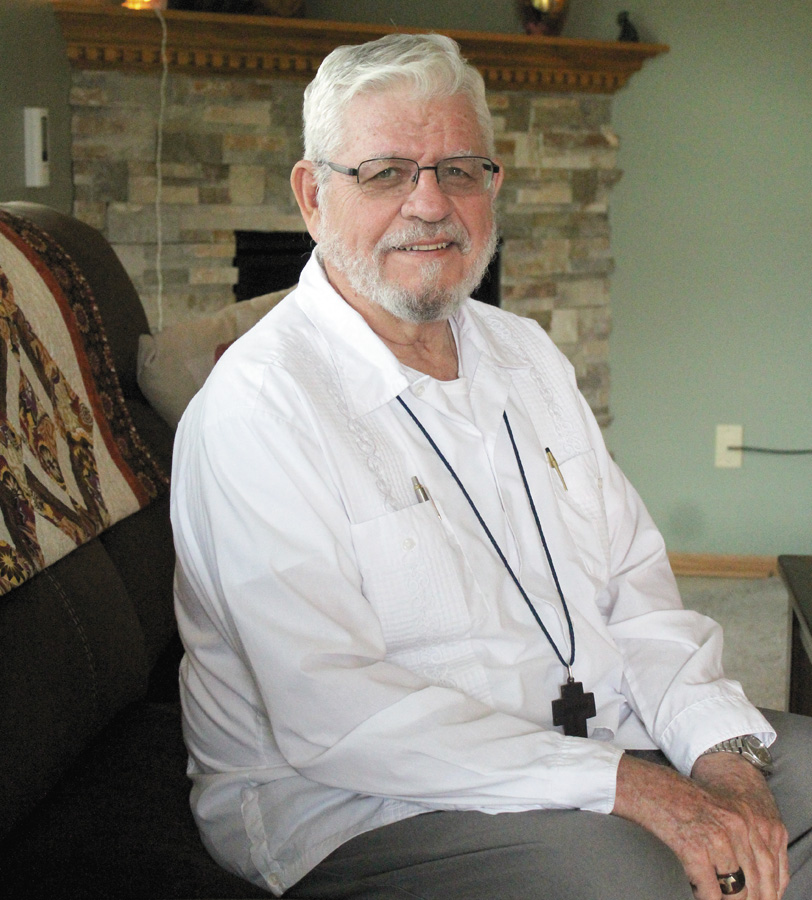Though Bishop Paul Schmitz has now spent almost his entire priesthood — and more than half his life — preaching the Gospel in the remotest parts of Central America, missionary work was not a goal for the young graduate of St. Lawrence Seminary High School as he discerned the priesthood in the early 1960s.
“I didn’t want to become a missionary,” he quipped. “So I joined the Capuchins.”
But either God or the Capuchins — or both — had other ideas. Schmitz was ordained to the priesthood in 1970, receiving a theology degree from Washington, D.C.’s, Capuchin College a year later alongside classmates Sean O’Malley and Charles Chaput.
He was sent to Mexico for a six-month language and acculturation course, and when his superiors asked him to go to Nicaragua for a few years, he figured it would be good fieldwork for the cultural anthropology graduate degree he was pursuing.

“A few years in Nicaragua” has turned into more than 45 years for Bishop Paul Schmitz, OFM,Cap. (Submitted photo)
That was 45 years ago, and Nicaragua is still home — though he keeps close ties with Wisconsin, returning for regular visits with family and colleagues. On a recent visit to his home state, Bishop Schmitz met with the Catholic Herald to discuss his unexpected life in Nicaragua, the people of his vicariate, and what all Catholics can learn from them.
A wash-and-wear shepherd
What’s the one accessory a bishop in the tropics can’t live without? A wash-and-wear miter.
“It gets dirty very fast,” he said. “You have to carry it in a saddlebag.”
That wash-and-wear miter — flexible and resilient— is perhaps the image that best personifies Bishop Schmitz’s episcopal sensibilities. His vicariate is large, rural and lacking in infrastructure like roads and electricity. Reaching the 1,100 communities spread out over the 23 square miles of territory is literally a labor of love.
But, Bishop Schmitz has taken the words of Pope Francis to heart: he is determined to smell like his sheep.
And what, precisely, do those words mean to Bishop Schmitz, whose vicariate includes more than 1 million residents, 70 percent of them Catholic?
It’s a tall order.
For his part, Bishop Schmitz has always known that being the Apostolic Vicar of Bluefields would not hold much glamour. His 1984 episcopal ordination took place in a tiny church in Rama, along the Escondido River — simply because at the time, there was no road to the See City of Bluefields. Because of the Contra War, the consecrating bishops would be unable to reach the cathedral.
In the line of fire
Bishop Schmitz’s time in Nicaragua has spanned several natural disasters (he was buried beneath the rubble of a collapsed sacristy for 20 minutes after a magnitude 6.2 earthquake in 1972), a revolution and political instability. He found himself literally in the middle of the Contra War on New Year’s Day in 1990 when guerilla fighters ambushed the car he was riding in with three Sisters of St. Agnes.
The group was en route to deliver Christmas presents to the village of Rosita when the contras, mistaking the bishop and sisters for Sandinistas, fired a grenade launcher at their vehicle near Ojo de Agua.
Sr. Maureen Courtney, a Milwaukee native, was killed at the age of 45, along with a young Nicaraguan nun, Sr. Teresa de Jesus. Bishop Schmitz still visits their graves regularly; it was a harrowing experience, and one that the bishop couldn’t bring himself to discuss for several years — until the Feast of Our Lady of Fatima a few years ago, when a group of people approached him after the dedication of a local church.
They were from Ojo de Agua, they said — and they were looking for forgiveness.
“They said … we were giving shelter to the contras, and some of our men also participated in the ambush — we want to ask for pardon,” he said.
The group requested a community penance, a 6-mile Way of the Cross to be completed during Holy Week the following year. The entire town made the pilgrimage, said Bishop Schmitz.
“It did a lot of healing, both for them and for me,” he said. “You come to a point where you realize the bullets have no names on them.”
An appreciation for the Eucharist
At 73, Bishop Schmitz is less than two years away from the compulsory age for bishops to resign their office. Because of the drastic increase in the vicariate’s population over the last few decades, Bishop Schmitz and auxiliary Bishop David Zywiec have asked the Holy See to divide the vicariate into several different dioceses. Plans for a new cathedral in the city of Siuna, where one of the suffragan dioceses will be headquartered, are underway.
The ratio of priests to lay people in the vicariate — 34 priests to approximately 700,000 faithful — is so unbalanced that the communities must go months without receiving the Eucharist.
But the scarcity of the celebration of the Eucharist has only made the faithful’s hunger for it keener, said Bischop Schmitz, and he urges those in more developed nations to take a cue from the faithful of the Vicariate
of Bluefields.
“They have a deeper appreciation for the Eucharist because they don’t get it that often. At the same time, they have (more of a devotion to) the Bible.”
Their faith, it seems, is as durable as the miter their bishop carries in a saddlebag over roads, fields and rivers to visit them.
Fundraising efforts are underway for the future cathedral of the diocese of Siuna, and contributions are needed.
Donations can be sent to the Capuchin Franciscan Province of St. Joseph, 1820 Mt. Elliott St., Detroit, MI 48207, designated Alms for the Siuna Cathedral.
